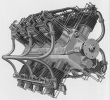
Selected Early Engines
Viking, Vivinus
Compiled by Kimble D. McCutcheon
Published 29 Jun 2023
Viking
 |
| Viking (AEE) |
During 1919, the Detroit Manufacturers' Syndicate, Inc. of Detroit, Michigan, announced the Viking, an air-cooled X-16 consisting of four 4-cylinder banks set a 90° to one another. With a 3.250" (82.55 mm) bore, 4.000" (101.6 mm) stroke and 530.93 in³ (8.700 l) displacement, it developed 140 hp at 1,600 rpm and weighed 306 lb (139 kg). The individual semi-steel cylinders with integral cooling fins were attached to the aluminum alloy crankcase by four flange bolts and four long binding bolts. The built-up crankshaft used annular ball bearings throughout. There were eight crank throws, eleven main bearings, and sixteen connecting rod bearings since the connecting rods were arranged side by side on the crankpins. A camshaft, situated in both upper and lower Vees, operated the inlet and exhaust valves in each cylinder head through push rods and rockers. Each valve had a 1.4375" (37.47 mm) clear opening and 0.3125" (7.94 mm) lift. The pistons were alumuinunm alloy. Oil from a pump via the upper hollow camshaft sprayed the engine interior to provided lubrication. A scavenge pump circulated the scavenge oil back to the tank. Dixie magnetos furnished ignition.
Vivinus (Aerosphere 1939, Wikipedia)
 |
| Vivinus 50 hp (AEE) |
Automobiles Vivinus S.A. was founded in Schaerbeek, Brussels by Alexis Vivinus (1860-1929) in 1899. The company began making aero engines in 1908, but by 1912 was liquidated and taken over by Fabrique Automobile Belge. Alexis Vivinus later joined Minerva.
All Vivinus aero engines were water-cooled vertical fours with pressed-steel flywheels. The valves, located in the cylinder head, were operated by push rods and rocker arms.
The smaller Vivinus engine had a 106 mm (4.173") bore, 120 mm (4.724") stroke, 4.236 l (258.49 in³) displacement and was rated 32.5 hp at 1,600 rpm.
Another model had a 112 mm (4.409") bore, 130 mm (5.118") stroke, 5.123 l (312.63 in³) displacement, produced 37.5 hp at 1,600 rpm and weighed 152 kg (336 lb).
A Vivinus engine with a 115 mm (4.528") bore, 130 mm (5.118") stroke and 5.401 l (329.60 in³) displacement was rated 39 hp at 1,800 rpm and weighed 127 kg (280 lb).
A later design with open propeller reduction gearing was rated at 50 hp and weighed 136 kg (300 lb). Two of these engines each rated 60 hp powered the airship Belgique, that was launched in 1909.
References
Angle, Glenn D, ed. Aerosphere 1939 (New York, New York: Aircraft Publications, 1940).
Anble, Glenn D, ed. Airplane Engine Encyclopedia (Dayton, Ohio: Otterbein Press, 1921).
Image Sources: A39 = Aerosphere 1939; AEE = Airplane Engine Encyclopedia; Flt = Flight Magazine; NARA = U.S. National Archives and Records Administration; UKNA = United Kingdom National Archives; Wiki = Wikimedia Commons (mouse over for details).